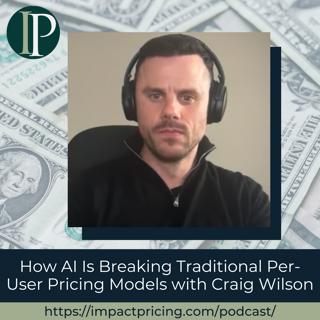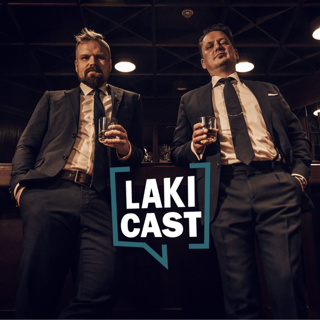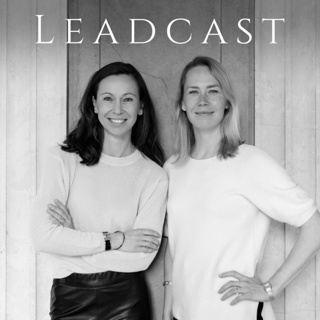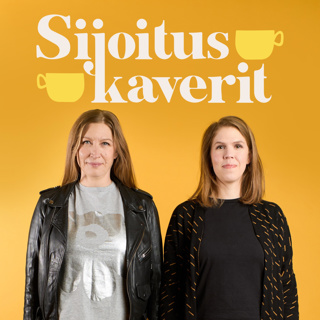
Why Pricing Deserves a Seat at the CEO Table with John Norkus
John Norkus is the founder of chiefpricingofficer.com and has led pricing transformation teams at several large consulting companies including Deloitte and KPMG. He started his career as an aircraft engineer before transitioning into business, bringing his analytical mindset to understanding the behavioral economics of pricing decisions. In this episode, John makes a compelling case for why pricing professionals deserve a seat at the executive table, exploring the disconnect between pricing's impact on enterprise value and its typical organizational placement. He discusses his new platform designed to unite senior pricing professionals and elevate the discipline to C-suite recognition. Why you have to check out today's podcast: Discover why pricing professionals are typically buried 2-3 levels below the CEO despite controlling one of four key profit drivers. Learn the difference between traditional pricing roles and true chief pricing officer responsibilities. Understand how to position pricing as enterprise value creation rather than just cost management. "Pricing may be part marketing, part analytics, part behavioral, part external, part internal, but it is the piece that aligns us on how we're actually squaring off against the market." – John Norkus Topics Covered: 01:43 – John's journey to pricing transformation: From aircraft engineer to behavioral economics and CRM to pricing strategy 05:18 – Positioning pricing as organizational connective tissue: Why pricing deserves equal footing with volume, cost, and mix initiatives 08:01 – The pricing control dilemma among departments: How sales, marketing, finance, and operations all claim ownership of pricing decisions 12:24 – Defining the Chief Pricing Officer's role: Executive alignment versus operational pricing work and transformation implementation 15:45 – Pricing strategies in business: Inside-out versus outside-in approaches and competitive intelligence versus customer willingness to pay 16:32 – Critical senior alignment in pricing projects: Why CEO buy-in as a top-3 initiative determines transformation success or failure 19:39 – Pricing and enterprise value analysis: Demonstrating 2-7% bottom-line impact within 12-18 months to justify executive investment 23:35 – The activist CFO and enterprise value: Finding CFOs who understand value creation beyond cost reduction and margin improvement 29:29 – Pricing as organizational alignment: How pricing serves as the ultimate test of market positioning and competitive strategy Key Takeaways: "If the pricing transformation of the pricing program isn't number one on the CEO's list of one, two, or three most important thing they can do this year... then quite frankly, it's not as important and it doesn't have the kind of alignment that you thought it did." – John Norkus "Organizations who get it are the ones that we should be engaging with... change comes from within. And if somebody believes that this is the right thing to do and they just need somebody to help them do it and somebody who has done it before, that's where people like you and I actually succeed." – John Norkus "I consider 20% of everything we do in pricing to be analytics or data and objective based, and the other 80% to be about behaviors, either internal behaviors or external behaviors that need to be captured and understood." – John Norkus People / Resources Mentioned: Professional Pricing Society (PPS): Established organization for pricing professionals and education Simon Sinek Four Drivers of Enterprise Profit: Volume, Cost, Mix, and Price - and their typical organizational reporting structures Connect with John Norkus: LinkedIn: https://www.linkedin.com/in/johnmnorkus/ Email: john@chiefpricingofficer.com Website: https://www.chiefpricingofficer.com/ Connect with Mark Stiving: LinkedIn: https://www.linkedin.com/in/stiving/ Email: mark@impactpricing.com
25 Elo 31min

Blogcast: When Pricing Becomes Sleazy Manipulation
This is an Impact Pricing Blog published on June 23, 2025, turned into an audio podcast so you can listen on the go. Read Full Article Here: https://impactpricing.com/blog/when-pricing-becomes-sleazy-manipulation/ If you have any feedback, definitely send it. You can reach us at mark@impactpricing.com. Now, go make an impact. Connect with Mark Stiving: Email: mark@impactpricing.com LinkedIn: https://www.linkedin.com/in/stiving/
22 Elo 6min

How Many Agents Should Pricing Software Have? with Steven Forth
Steven Forth is the founder and CEO of Ibbaka and by far Impact Pricing's most frequent guest. He's currently developing ValueIQ, a set of agents for pricing and value advisory work that will soon be available for broader use. In this episode, Steven discusses his recent research comparing agent strategies across four major pricing software companies, explores the fundamental question of how many agents is optimal, and reveals how AI is transforming both the buying and selling process in ways most companies aren't prepared for. Why you have to check out today's podcast: Learn how the four major pricing software companies (Pros, Vendavo, Zilliant, PriceFX) approach agent development differently. Discover the key difference between role-based and task-based agent design strategies. Understand how AI will fundamentally change B2B buying processes and what that means for pricing. "Start using AI to get a deeper understanding of how your customers are buying. Because if you don't understand how your customers are buying and buying using AI, you're not going to be able to price properly." – Steven Forth Topics Covered: 02:07 – ValueIQ introduction: Steven's new agent platform for pricing and value advisory work 06:34 – Defining agents: The difference between true agentic AI and wrapped LLM functionality 10:49 – Sales agent complexity: Breaking down the many tasks salespeople perform and agent granularity 12:35 – Pricing agents vs. features: How to decide between individual pricing and bundling strategies 15:55 – The future of pricing models: Why "good, better, best" packaging may disappear in 2-3 years 21:05 – AI's role in B2B buying: How AI intermediaries will transform RFP processes and vendor selection 25:06 – Understanding AI-powered customers: Why companies must learn how their buyers use AI in purchasing decisions Key Takeaways: "When I saw that PriceFX announced that it had more than 125 agents... I thought, huh, that's kind of a jaw-dropping number. I don't think I could generate 125 agents for pricing software." – Steven Forth "The role of AI in the buying process is more important than the role of AI in the sales process." – Steven Forth "You're going to be creating more content, not less. But that content is primarily going to be consumed by AIs." – Steven Forth "I think that many of the common packaging assumptions such as good, better, best are going to dissolve away over the next two or three years." – Steven Forth Resources Mentioned: Michael Mansard's 14-factor model: https://www.linkedin.com/in/michaelmansard/ Connect with Steven Forth: LinkedIn: https://www.linkedin.com/in/stevenforth/ Email: steven@ibbaka.com Connect with Mark Stiving: LinkedIn: https://www.linkedin.com/in/stiving/ Email: mark@impactpricing.com
18 Elo 27min

Blogcast: The Secret Link Between Market Segments and the “Will I” Decision
This is an Impact Pricing Blog published on June 16, 2025, turned into an audio podcast so you can listen on the go. Read Full Article Here: https://impactpricing.com/blog/the-secret-link-between-market-segments-and-the-will-i-decision/ If you have any feedback, definitely send it. You can reach us at mark@impactpricing.com. Now, go make an impact. Connect with Mark Stiving: Email: mark@impactpricing.com LinkedIn: https://www.linkedin.com/in/stiving/
15 Elo 5min

How to Turn Vendors Into Paying Customers (And Other Pricing Secrets) with Ashish Gupta
Ashish Gupta, founder and CEO of ScaleUp Exec, brings a unique perspective to pricing from his experience building and selling multiple companies across technology, e-commerce, and subscription businesses. Starting his career at Anheuser-Busch (as the company's only non-drinker), Ashish has led businesses from startup to eight-figure valuations, giving him deep insights into pricing across different business models and growth stages. In this episode, Ashish shares unconventional pricing strategies that transformed his businesses, including how he convinced vendors to provide products for free by repositioning his company as a marketing partner rather than a traditional retailer. Why you have to check out today's podcast: Discover how to identify and target the specific customer segments willing to pay premium prices for your unique value proposition. Learn the "influencer plus" strategy that transforms vendor relationships from cost centers into revenue-generating partnerships. Understand how subscription businesses create deeper customer relationships and the pricing implications of holding customer credit cards. "Instead of trying to go to a general audience, which may or may not be interested in paying you more for something unique about your product, really try and understand who is that core set of people that will find real value and be willing to pay for that value." – Ashish Gupta Topics Covered: 01:48 — Ashish's entrepreneurial journey: From Anheuser-Busch to multiple successful exits. 03:42 — The psychology of subscription pricing: Why holding credit cards creates deeper customer relationships. 07:54 — Win, Keep, Grow framework: The often-overlooked "grow" component in subscription businesses. 11:03 — ScaleUp Exec's fractional COO model: Bringing enterprise talent to small and medium businesses. 13:45 — Revenue growth strategies: How COOs approach customer acquisition and diversification differently. 17:34 — The pricing audit revelation: Why PE firms consistently find underpriced acquisitions. 22:01 — The "off balance sheet CFO" positioning strategy for premium pricing. 22:58 — The vendor flip strategy: From paying wholesale to getting products for free. 24:04 — Building the "influencer plus" model: Combining audience and distribution for vendor value. Key Takeaways: "I think relationship and subscription are, they kind of go hand in hand. That means I have to always be getting value. I have to have this confidence that, if somebody has my credit card and I've given them authorization to charge it versus like, let's say an Amazon, I'm proactively going in and saying, yes, I want this item." – Ashish Gupta "If we can build out our own audience, and grow that audience to be something meaningful and have a deep connection with that audience so that they really trust us, our brand as a retailer, then we can actually talk with our vendors and say, hey, we're no longer a retailer, we're really a marketing company." – Ashish Gupta Resources and People Mentioned: Anheuser-Busch: https://www.anheuser-busch.com Shopify Shop Pay: https://www.shopify.com/shop-pay PayPal: https://www.paypal.com/ Mark Stiving's book: "Win, Keep, Grow" about subscription businesses Connect with Ashish Gupta: Website: https://scaleupexec.com/ Linkedin: https://www.linkedin.com/in/ashish-gup/ Connect with Mark Stiving: LinkedIn: https://www.linkedin.com/in/stiving/ Email: mark@impactpricing.com
11 Elo 28min

Blogcast: Why Pricing AI Is So Hard
This is an Impact Pricing Blog published on June 9, 2025, turned into an audio podcast so you can listen on the go. Read Full Article Here: https://impactpricing.com/blog/why-pricing-ai-is-so-hard/ If you have any feedback, definitely send it. You can reach us at mark@impactpricing.com. Now, go make an impact. Connect with Mark Stiving: Email: mark@impactpricing.com LinkedIn: https://www.linkedin.com/in/stiving/
8 Elo 3min

How AI Is Breaking Traditional Per-User Pricing Models with Craig Wilson
Craig Wilson, Director of Pricing and Packaging at Moody's Analytics, brings extensive experience from major financial services companies including S&P and Experian. Starting his career in financial analysis at a Scottish car retailer after his soccer dreams didn't materialize, Craig discovered his natural strengths in numbers and analytical tools, leading him to specialize in pricing across subscription products, deal desk operations, and information technology services. In this episode, Craig explores the dual challenge of AI in pricing: how to monetize AI-enhanced products and how to leverage AI tools for pricing decisions. Drawing from his experience at Moody's, he discusses why traditional pricing principles still apply to AI products while acknowledging the fundamental disruption AI creates for per-user models. Craig shares practical insights on using AI as a pricing coach and the critical importance of early involvement in product development. Why you have to check out today's podcast: Learn why AI pricing follows traditional value-based principles but requires new approaches to pricing metrics and value capture. Discover practical ways to use AI tools like Microsoft Copilot for pricing strategy, stakeholder communication, and sales enablement. Understand the critical timing of pricing involvement in AI product development to influence monetization strategies from the ground up. "Get involved in the product development process as early as possible, particularly in the era of Gen AI and agentic AI." – Craig Wilson Topics Covered: 01:30 — Craig's pricing journey: From Scottish car retailer to Moody's Analytics pricing leader 04:15 — Why AI pricing fundamentals haven't changed: Still about value creation and capture 06:30 — The consensus problem: No clear patterns yet in AI pricing 08:45 — Use case example: using AI to do pricing 11:15 — Using AI as a pricing coach: Daily conversations with Microsoft Copilot for strategy development 14:30 — Communication enhancement: Translating pricing concepts for different business personas 16:45 — Sales enablement evolution: AI-powered guidance for complex solution positioning 19:20 — Trust and validation concerns: The information vs. agentic AI distinction 21:45 — Economic value estimation: How AI can finally make this pricing holy grail practical 23:30 — The monetization investment gap: Companies building AI capabilities without pricing strategies Key Takeaways: On Early Involvement in Product Development: "Get involved in the product development process as early as possible, particularly in the era of Gen AI and agentic AI." – Craig Wilson On Per-User Pricing's Death: "In the world of particularly agentic AI solutions, the per-user model is becoming obsolete. I can't see a place for it." – Craig Wilson Resources and People Mentioned: Moody's Analytics: https://www.moodysanalytics.com/ Tom Nagle: "Strategy and Tactics of Pricing" book: https://www.taylorfrancis.com/books/mono/10.4324/9781315266220/strategy-tactics-pricing-thomas-nagle-john-hogan-joseph-zale Steven Forth: https://www.linkedin.com/in/stevenforth/ Kyle Poyar: https://www.linkedin.com/in/kyle-poyar/ Stuart Wintertere: LinkedIn thought leader on AI value Microsoft Copilot: Daily AI coaching tool Connect with Craig Wilson: LinkedIn: https://www.linkedin.com/in/craig-wilson-5857ba4a/ Email: craig.wilson@moodys.com Connect with Mark Stiving: LinkedIn: https://www.linkedin.com/in/stiving/ Email: mark@impactpricing.com
4 Elo 25min

Blogcast: Jobs to Be Done vs. Problems and Results: What’s More Useful in B2B?
This is an Impact Pricing Blog published on June 2, 2025, turned into an audio podcast so you can listen on the go. Read Full Article Here: https://impactpricing.com/blog/jobs-to-be-done-vs-problems-and-results-whats-more-useful-in-b2b/ If you have any feedback, definitely send it. You can reach us at mark@impactpricing.com. Now, go make an impact. Connect with Mark Stiving: Email: mark@impactpricing.com LinkedIn: https://www.linkedin.com/in/stiving/
1 Elo 3min






















